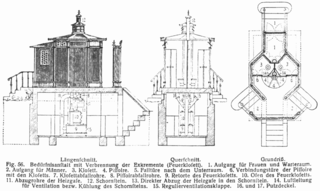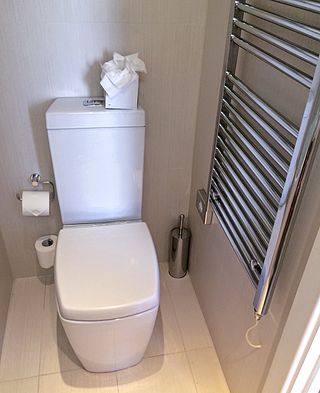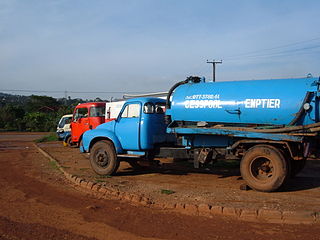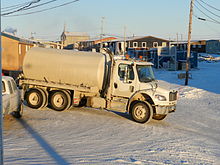
An outhouse is a small structure, separate from a main building, which covers a toilet. This is typically either a pit latrine or a bucket toilet, but other forms of dry (non-flushing) toilets may be encountered. The term may also be used to denote the toilet itself, not just the structure.

A portable or mobile toilet is any type of toilet that can be moved around, some by one person, some by mechanical equipment such as a truck and crane. Most types do not require any pre-existing services or infrastructure, such as sewerage, but are completely self-contained. The portable toilet is used in a variety of situations, for example in urban slums of developing countries, at festivals, for camping, on boats, on construction sites, and at film locations and large outdoor gatherings where there are no other facilities. Most portable toilets are unisex single units with privacy ensured by a simple lock on the door. Some portable toilets are small molded plastic or fiberglass portable rooms with a lockable door and a receptacle to catch the human excreta in a container.

Night soil is a historically used euphemism for human excreta collected from cesspools, privies, pail closets, pit latrines, privy middens, septic tanks, etc. This material was removed from the immediate area, usually at night, by workers employed in this trade. Sometimes it could be transported out of towns and sold on as a fertilizer.
Human waste refers to the waste products of the human digestive system, menses, and human metabolism including urine and feces. As part of a sanitation system that is in place, human waste is collected, transported, treated and disposed of or reused by one method or another, depending on the type of toilet being used, ability by the users to pay for services and other factors. Fecal sludge management is used to deal with fecal matter collected in on-site sanitation systems such as pit latrines and septic tanks.

Cesspit, cesspool and soak pit in some contexts are terms with various meanings: they are used to describe either an underground holding tank or a soak pit. A cesspit can be used for the temporary collection and storage of feces, excreta or fecal sludge as part of an on-site sanitation system and has some similarities with septic tanks or with soak pits. Traditionally, it was a deep cylindrical chamber dug into the ground, having approximate dimensions of 1 metre (3') diameter and 2–3 metres depth. Their appearance was similar to that of a hand-dug water well.

A chemical toilet collects human excreta in a holding tank and uses chemicals to minimize odors. They do not require a connection to a water supply and are used in a variety of situations. These toilets are usually, but not always, self-contained and movable. A chemical toilet is structured around a relatively small tank, which needs to be emptied frequently. It is not connected to a hole in the ground, nor to a septic tank, nor is it plumbed into a municipal system leading to a sewage treatment plant. When the tank is emptied, the contents are usually pumped into a sanitary sewer or directly to a treatment plant.

A bucket toilet is a basic form of a dry toilet whereby a bucket (pail) is used to collect excreta. Usually, feces and urine are collected together in the same bucket, leading to odor issues. The bucket may be situated inside a dwelling, or in a nearby small structure.

A dump station is a place where raw sewage may be entered into a sanitary sewer system in a safe and responsible way. Dump stations are often used by owners of motorhomes, campervans, recreational vehicles or boats that are equipped with toilet facilities and a sewage holding tank, also known as a blackwater holding tank. The holding tank can be safely emptied at a dump station. Greywater holding tanks can also be emptied at a dump station.

An incinerating toilet is a type of dry toilet that burns human feces instead of flushing them away with water, as does a flush toilet.
Manual scavenging is a term used mainly in India for "manually cleaning, carrying, disposing of, or otherwise handling, human excreta in an insanitary latrine or in an open drain or sewer or in a septic tank or a pit". Manual scavengers usually use hand tools such as buckets, brooms and shovels. The workers have to move the excreta, using brooms and tin plates, into baskets, which they carry to disposal locations sometimes several kilometers away. The practice of employing human labour for cleaning of sewers and septic tanks is also prevalent in Bangladesh and Pakistan. These sanitation workers, called "manual scavengers", rarely have any personal protective equipment. The work is regarded as a dehumanizing practice.
Honey Wagon may refer to:

A toilet is a piece of sanitary hardware that collects human urine and feces, and sometimes toilet paper, usually for disposal. Flush toilets use water, while dry or non-flush toilets do not. They can be designed for a sitting position popular in Europe and North America with a toilet seat, with additional considerations for those with disabilities, or for a squatting posture more popular in Asia, known as a squat toilet. In urban areas, flush toilets are usually connected to a sewer system; in isolated areas, to a septic tank. The waste is known as blackwater and the combined effluent, including other sources, is sewage. Dry toilets are connected to a pit, removable container, composting chamber, or other storage and treatment device, including urine diversion with a urine-diverting toilet.

A sanitation worker is a person responsible for cleaning, maintaining, operating, or emptying the equipment or technology at any step of the sanitation chain. This is the definition used in the narrower sense within the WASH sector. More broadly speaking, sanitation workers may also be involved in cleaning streets, parks, public spaces, sewers, stormwater drains, and public toilets. Another definition is: "The moment an individual’s waste is outsourced to another, it becomes sanitation work." Some organizations use the term specifically for municipal solid waste collectors, whereas others exclude the workers involved in management of solid waste sector from its definition.

A vacuum truck, vacuum tanker, vactor truck, vactor, vac-con truck, vac-con is a tank truck that has a pump and a tank. The pump is designed to pneumatically suck liquids, sludges, slurries, or the like from a location into the tank of the truck. The objective is to enable transport of the liquid material via road to another location. Vacuum trucks transport the collected material to a treatment or disposal site, for example a sewage treatment plant.

A pail closet or pail privy or dirt closet was a room used for the disposal of human excreta, under the "pail system" of waste removal. The "closet" was a small outhouse (privy) which contained a seat, underneath which a portable receptacle was placed. This bucket (pail), into which the user would defecate, was removed and emptied by the local authority on a regular basis. The contents, known euphemistically as night soil, would either be incinerated or composted into fertiliser.

A dry toilet is a toilet which, unlike a flush toilet, does not use flush water. Dry toilets do not use water to move excreta along or block odors. They do not produce sewage, and are not connected to a sewer system or septic tank. Instead, excreta falls through a drop hole.
The privy midden was a toilet system that consisted of a privy (outhouse) associated with a midden. They were widely used in rapidly expanding industrial cities such as Manchester in England, but were difficult to empty and clean. A typical comment was that they were of "most objectionable construction" and "usually wet and very foul". They were replaced eventually by pail closets and flush toilets. Similar systems still exist in some developing countries, but the term "privy midden" is now an archaism.

A urine-diverting dry toilet (UDDT) is a type of dry toilet with urine diversion that can be used to provide safe, affordable sanitation in a variety of contexts worldwide. The separate collection of feces and urine without any flush water has many advantages, such as odor-free operation and pathogen reduction by drying. While dried feces and urine harvested from UDDTs can be and routinely are used in agriculture, many UDDT installations do not apply any sort of recovery scheme. The UDDT is an example of a technology that can be used to achieve a sustainable sanitation system. This dry excreta management system is an alternative to pit latrines and flush toilets, especially where water is scarce, a connection to a sewer system and centralized wastewater treatment plant is not feasible or desired, fertilizer and soil conditioner are needed for agriculture, or groundwater pollution should be minimized.

Fecal sludge management (FSM) is the storage, collection, transport, treatment and safe end use or disposal of fecal sludge. Together, the collection, transport, treatment and end use of fecal sludge constitute the "value chain" or "service chain" of fecal sludge management. Fecal sludge is defined very broadly as what accumulates in onsite sanitation systems and specifically is not transported through a sewer. It is composed of human excreta, but also anything else that may go into an onsite containment technology, such as flushwater, cleansing materials, menstrual hygiene products, grey water, and solid waste. Fecal sludge that is removed from septic tanks is called septage.
The term recreational vehicle (RV) is often used as a broad category of motor vehicles and trailers which include living quarters for designed temporary accommodation. Types of RVs include motorhomes, campervans, caravans, fifth-wheel trailers, popup campers, truck campers and Park Model RVs.















